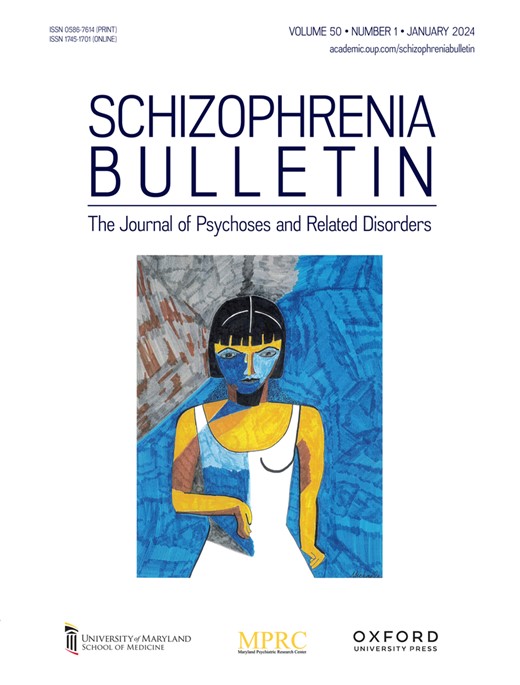精神分裂症患者主观幸福感的决定因素建模
IF 5.3
1区 医学
Q1 PSYCHIATRY
引用次数: 0
摘要
背景 成功治疗精神分裂症的最终目标不仅是缓解精神症状,还要减少痛苦并获得主观幸福感(SWB)。我们旨在确定精神分裂症患者主观幸福感的决定因素及其相互关系。方法 我们从参加多中心、开放标签、非比较性临床试验的 637 名精神分裂症患者中获得了数据。采用神经安定剂治疗量表(SWN)中的SWB;80分的临界值表示基线和6个月时的SWB水平较高。研究采用了多种机器学习(ML)算法来确定 SWB 的决定因素。此外,还进行了网络分析和结构方程建模 (SEM),以探索详细的关系模式。结果 随机森林(RF)模型在基线时的曲线下面积(AUC)最高,为 0.794。强迫症状(OCS)对高水平 SWB 的影响最大,其次是躯体化、认知障碍和抑郁。网络分析显示,SWB、强迫症状和躯体化之间存在紧密联系。SEM 分析表明,OCS 对 SWB 有最强的直接影响,并通过抑郁的中介作用产生间接影响。此外,基线时的 OCS 对 SWB 的影响在 6 个月后依然存在。结论 在精神分裂症患者中,OCS、躯体化、认知和抑郁,而非精神病性症状,对SWB有显著影响。值得注意的是,OCS 不仅对当前的幸福感,而且对后续的 SWB 都有最显著的影响,这意味着 OCS 对 SWB 有预测作用。研究结果表明,OCS管理对于精神分裂症的治疗至关重要。本文章由计算机程序翻译,如有差异,请以英文原文为准。
Modeling the Determinants of Subjective Well-Being in Schizophrenia
Background The ultimate goal of successful schizophrenia treatment is not just to alleviate psychotic symptoms, but also to reduce distress and achieve subjective well-being (SWB). We aimed to identify the determinants of SWB and their interrelationships in schizophrenia. Methods Data were obtained from 637 patients with schizophrenia enrolled in multicenter, open-label, non-comparative clinical trials. The SWB under the Neuroleptic Treatment Scale (SWN) was utilized; a cut-off score of 80 indicated a high level of SWB at baseline and 6 months. Various machine learning (ML) algorithms were employed to identify the determinants of SWB. Furthermore, network analysis and structural equation modeling (SEM) were conducted to explore detailed relationship patterns. Results The random forest (RF) model had the highest area under the curve (AUC) of 0.794 at baseline. Obsessive-compulsive symptoms (OCS) had the most significant impact on high levels of SWB, followed by somatization, cognitive deficits, and depression. The network analysis demonstrated robust connections among the SWB, OCS, and somatization. SEM analysis revealed that OCS exerted the strongest direct effect on SWB, and also an indirect effect via the mediation of depression. Furthermore, the contribution of OCS at baseline to SWB was maintained 6 months later. Conclusions OCS, somatization, cognition, and depression, rather than psychotic symptoms, exerted significant impacts on SWB in schizophrenia. Notably, OCS exhibited the most significant contribution not only to the current state of well-being but also to follow-up SWB, implying that OCS was predictive of SWB. The findings demonstrated that OCS management is critical for the treatment of schizophrenia.
求助全文
通过发布文献求助,成功后即可免费获取论文全文。
去求助
来源期刊

Schizophrenia Bulletin
医学-精神病学
CiteScore
11.40
自引率
6.10%
发文量
163
审稿时长
4-8 weeks
期刊介绍:
Schizophrenia Bulletin seeks to review recent developments and empirically based hypotheses regarding the etiology and treatment of schizophrenia. We view the field as broad and deep, and will publish new knowledge ranging from the molecular basis to social and cultural factors. We will give new emphasis to translational reports which simultaneously highlight basic neurobiological mechanisms and clinical manifestations. Some of the Bulletin content is invited as special features or manuscripts organized as a theme by special guest editors. Most pages of the Bulletin are devoted to unsolicited manuscripts of high quality that report original data or where we can provide a special venue for a major study or workshop report. Supplement issues are sometimes provided for manuscripts reporting from a recent conference.
 求助内容:
求助内容: 应助结果提醒方式:
应助结果提醒方式:


